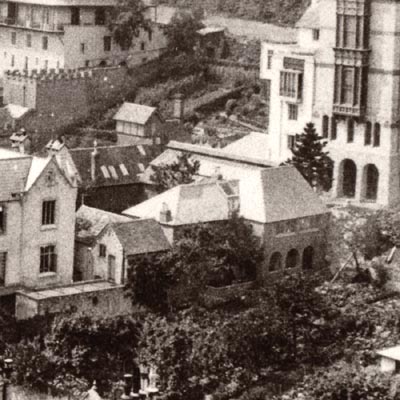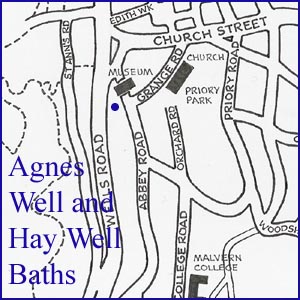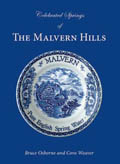
| 
|


Agnes Well and the Hay Well Baths
NGR 77520 45750
Site Number: C110
By Bruce Osborne and Cora Weaver (C) 2012
Area 1. Malvern Town Centre Springs and Wells
Malvern Hills, England
Description: a well, no longer accessible
The principal water source associated with the Hay Well Baths was the Hay Well and this is dealt with separately. The second well at the Hay Well Baths was located beneath the corridor of the ladies baths and was designated Agnes' Well (or St Agnes' Well). It is referred to as being older than the Hay Well and is though to have once supplied farm buildings on the site of the Baptist Church.[1] Located in the basement or cellar, it possibly provided water with the aid of a pump for the horses stabled there.
St Agnes was the patroness of the well and was a gifted and beautiful Roman lady from a noble family. Being a follower of Christian ethics she refused the hand of the son of Sempronius, the Governor of Rome, because he was not Christian. In spite of a combination of bribes and punishments she refused to be coerced into what she considered an inappropriate relationship. As a result Sempronius condemned her to death by burning. On the day of her execution the fire was kindled but miraculously did little injury to her. When this was observed she was dragged from the fire and by order of Auspitius, was beheaded by a common executioner. This martyrdom occurred when she was thirteen years old in AD 304.[2]
Jordan identifies the exact location of the St Agnes Well with a plan of the Hay Well Baths. The site of the baths and the surrounding area has undergone considerable alteration over the years, especially with the construction of the Baptist Church itself, opened in 1894.[3] Henry Hillyard, Sanitary Inspector of Malvern Urban District Council was of the view that the Agnes Well was likely a domestic supply to former farm buildings on the Baptist Church site.[4]
The Hay Well Baths
In the early 1830s George Warwick bought a piece of land on the north side of the Well-Hay and in 1833 opened a high class draper's shop. The following year, 1834, he bought a piece of land from the Grange Estate east of the shop and built an L-shaped complex of baths there. He named them: not the Well-Hay Baths but the Hay Well Baths. Dr Gully arrived in Malvern in 1842, took over the baths for his wealthy hydropathic patients. He is said to have personally treated the Wilberforce family here in 1865.
With the development of hydropathy in Malvern the Hay Well thus became most important with the Hay Well Baths, comprising two sets of baths, female and male, erected on the site which lies between Warwick House (formerly Cox & Painter's) and alongside the Baptist Church.[5] The red brick building was several storeys high. The baths included a pump and engine and a header tank in a small water tower. In the 1840s Dr. Gully `elegantly fitted up... upon a very correct and improved principal' the Hay Well which was situated below George Warwick's shop.[6] Inside were separate baths for men and women offering warm, cold, shower, vapour and plunging baths, and dressing rooms. Later a Medical Gymnast from Sweden supposedly treated patients at the Haywell Baths.[7] It is said that Gully built baths adjoining the Hay Well but it is not known whether this is a reference to the Hay Well Baths or the Tudor Well Baths.[8] An 1884 advertisement for the Tudor House Hotel describes it as having baths close at hand and hot and cold water laid on to every room "from the world-celebrated Hay Well".[9]
Late 19th century plans of the Hay Well Baths, reproduced in Jordan[10], confirm separate facilities for ladies and gentlemen plus ancillary items such as a boiler and engine, the latter presumably being the pump. There was also a conservatory and gardens which overlooked the pool further down the slope. The plans also reveal two wells on the Baths site. One was the Hay Well which at that time was a public well outside the Hay Well Baths building with two piped supplies running east to Abbey House and three other houses. The other was the Agnes Well, which is dealt with separately. Years earlier it may have been the domestic supply to some farm buildings that stood where the Baptist Church now stands.
The Hay Well Baths were still in use towards the end of the 19th century and an advertisement in the Malvern Advertiser of 28 April 1883 noted that the celebrated Hay Well Baths had been reopened after thorough repair and improvements. The opening times were from 7am to 8pm and the Baths offered Rubbers, Chiropodists and Swimming Teachers. The advertisement was accompanied by a lengthy description of the facilities on behalf of the proprietor:
"BATHS - Our advertising columns announce the re-opening of the celebrated Hay Well Baths, under the management and direction of Mr A. King. We need hardly tell the intelligent reader that Hay Well is a corruption of Eye Well - the waters of which centuries ago was noted for the cure of opthalmia and other eye disorders. These baths, the reputation of which has been handed down through the long past, are a great boon whether considered merely for the ordinary purposes of bathing or for the application of the recommendation of modern Hydropathy. A long list is given from the Tepid Swimming Bath to the Russian or Chamber Vapour, to meet every demand and supply every necessity suggested by medical men... The Baths of Malvern cannot be too widely known nor their use too strongly recommended. In bygone days the reputation of the place was built on the virtues of the famous water, and we are of opinion that we have still to look to this as an important factor in maintaining its celebrity. The Hay Well Baths, under Mr and Mrs King's management, may be safely and strongly recommended to all by whom bathing in some form or other is practised."
Maintaining the Haywell Baths proved a blessing to the whole town: following the drought of 1883 and the failure of the Malvern Common Pumping Station to provide adequate water, temporary use was made of the steam pumps here to pump much-needed water into the mains.[11] During the 1883 drought there were 22.35" of rainfall; during the 1887 drought only 13.16" of rain fell. Once again the town was in dire need of the Haywell water. Following the proprietor's consent, the town Surveyor immediately laid pipes and began pumping into the mains. Mr King would of course be paid for the water![12]
In 1893/4 the Baptist Church was built, not over the Hay Well, as Smith and others suggest[13], but adjacent to the Hay Well Baths over the site of the Mason Tank. Jordan illustrates the Hay Well exposed with the building of the Collins Hall at the rear of the Baptist Church. The photograph shows the water from the well apparently being channeled towards the church and conforms with present day ground features. The comment in Smith, supplemented by comment in Jordan, who categorically states that the Baptist Church was built on the site of the Baths, has given the false impression that the baths were demolished at that time. This is not so. The site plan reproduced in Jordan clearly locates the Hay Well Baths to the north of the Baptist Church and the building can be identified from contemporary photographs.[14] Richardson, in 1930 published an analysis of the waters, dated 1905, confirming that the well was not lost with the building of the Baptist Church.[15]
The life of the refurbished baths was short lived. Within a few years they were leased as warehouses by Cox and Painter Ltd who owned Warwick House, the large and elegant shop above the baths on Wells Road. The lease expired in January 1905 and Cox and Painter Ltd decided not to renew it in an effort to save money. Some remains of the Hay Well Baths were discovered in 1969 during excavations to build a pre-fabricated building to the rear of the Baptist Church. Much of the original building survived until 2002 when the Warwick House site was totally refurbished and new houses built over the site of the Baths. The demolition of this historic building went unnoticed because most believed the Baptist Church had been built on the site of the former baths as indicated by Brian Smith et al.
1. Hay Well Baths in the 19th century as a two storey building. (courtesy Brian Iles)
3. Hay Well Baths just prior to demolition in 2002. (courtesy Mark Baker)
4. The site of the Hay Well Baths after redevelopment in 2002.
A floor layout of the Hay Well Baths is included under Hay Well.
Footnotes:
[1] Richardson L (1930) Wells and Springs of Worcs, p.118.
[2] Quiller-Couch M & L (1894) Ancient and Holy Wells of Cornwall, Clark, London. P.2,3.
[3] Jordan E K H (1987) The Church at the Hay Well, Malvern Baptist Church. p.19,46.
[4] Richardson L. (1926) Malvern Waters, Proceedings of the Cotteswold Naturalist Field Club vol.xxii pt.III. p.291.
[5] Richardson p.118.
[6] Smith p.198.
[7] Harcup 1992 p.65 & p.57.
[8] Richardson p.118.
[9] Malvern Advertiser 1 November 1884.
[10] Jordan 1987.
[11] Malvern Advertiser 24 November 1883.
[12] Malvern Advertiser 16 July 1887.
[13] Smith p.211.
[14] Jordan E K H (1987) The Church at the Hay Well, Malvern Baptist Church, p.17,46.
[15] Richardson 1930 p.165.

Website: Click Here
SUPPLEMENTARY INFORMATION

Celebrated Springs of
THE MALVERN HILLS
 A definitive work that is the culmination of 20 years researching the springs and wells of the Malvern Hills, published by Phillimore. This is the ideal explorers guide enabling the reader to discover the location and often the astounding and long forgotten history of over 130 celebrated springs and wells sites around the Malvern Hills. The book is hard back with dust cover, large quarto size with lavish illustrations and extended text. Celebrated Springs contains about 200 illustrations and well researched text over a similar number of pages, together with seven area maps to guide the explorer to the locations around the Malvern Hills. It also includes details on the long history of bottling water in the Malvern Hills.
A definitive work that is the culmination of 20 years researching the springs and wells of the Malvern Hills, published by Phillimore. This is the ideal explorers guide enabling the reader to discover the location and often the astounding and long forgotten history of over 130 celebrated springs and wells sites around the Malvern Hills. The book is hard back with dust cover, large quarto size with lavish illustrations and extended text. Celebrated Springs contains about 200 illustrations and well researched text over a similar number of pages, together with seven area maps to guide the explorer to the locations around the Malvern Hills. It also includes details on the long history of bottling water in the Malvern Hills.
Written by Bruce Osborne and Cora Weaver, this book is available on-line for £15.00 (delivered UK) - click Malvern Bookshop on the green panel top left. Alternatively send a cheque payable to Cora Weaver with your name and address to 4 Hall Green, Malvern, Worcs. WR14 3QX.
1) TOPOGRAPHICAL LOCATION:
Malvern Hills - arguably Britain's original National Park
2) LANDSCAPE:
Built Up Location3) INFORMATION CATEGORY:
A Spring, Spout, Fountain or Holy Well Site4) MALVERN SPRING OR WELL SITE DETAILS:
1 SPLASH - Lost - Nothing Much To See
5) GENERAL VISITOR INFORMATION:
Access On FootOn Private Property


